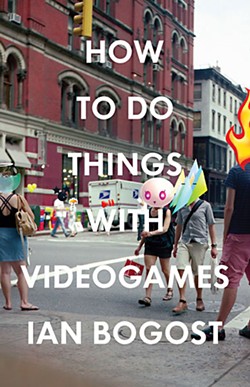 How to Do Things With Videogames might not be the book you're expecting it to be. It's not a game design book that discusses technical solutions, neither is it a book of videogame criticism focused on the effectiveness of individual titles. Rather, it's an eye-opener book meant to show anyone and everyone what has been done with videogames so far in their relatively short history. Indeed, a better title for this book might be How Things Have Been Done With Videogames. As such, it reads more like a highlight reel of Bogost's blog posts on videogames than a single argument that unfolds from chapter to chapter.
How to Do Things With Videogames might not be the book you're expecting it to be. It's not a game design book that discusses technical solutions, neither is it a book of videogame criticism focused on the effectiveness of individual titles. Rather, it's an eye-opener book meant to show anyone and everyone what has been done with videogames so far in their relatively short history. Indeed, a better title for this book might be How Things Have Been Done With Videogames. As such, it reads more like a highlight reel of Bogost's blog posts on videogames than a single argument that unfolds from chapter to chapter.Once you understand that purpose of this book, it's easy to see how well that purpose is fulfilled. The examples Bogost provides are varied and plentiful, allowing any curious reader to use the chapter on their topic(s) of choice as a starting point for a deeper study in a specific use of videogames. Rather than settling into the common and heated debate of "videogames as art," Bogost addresses that as simply one use for the medium in this book's first chapter, then moves on to much more varied and surprising uses for videogames, from empathy and kitsch to reverence and exercise.
While the individual chapters do not linearly unfold a single argument, Bogost frames the collection as evidence for one major point he wishes to make. He states this point explicitly in the introduction and conclusion: "We can understand the relevance of a medium by looking at the variety of things it does." The collection of essays that follows this introduction proves this point, which in turn is used to argue his final point in the conclusion: "Soon gamers will be the anomaly. If we're very fortunate, they'll disappear altogether. Instead we'll just find people of all sorts. And sometimes those people will play videogames. And it won't be a big deal, at all."
It may seem contradictory to write a book about videogames just to suggest that the gamer community will die out, but really what Bogost is trying to do is show how games will only continue to increase in use and relevance in our society such that we will no longer consider those who play videogames as some kind of specialized hobbyists. It's an interesting blend of hope and submission that Bogost presents the reader; videogames will indeed continue to grow in scope and legitimacy in society, but at the same time they will lose their edgy appeal and excitement until they become just another medium we interact with.
As Bogost says himself, this is certainly not headline material. It is, however, the most realistic and all-encompassing view of the future of videogames out there. The excitement of videogames as a medium is bound to die down in the coming years as current generations will grow up with them as a fact of daily life. When that happens, the excitement will come from individuals exploring and exploiting videogames' seemingly infinite uses in innovative and provocative ways. Bogost himself has done that elsewhere, but that's not what this book is about. This book is about showing the world videogames are here to stay and inviting us all to accept this new medium like we would any other, then inviting us to get past that and start using videogames as well and as interestingly as we do any other medium of expression.
See this review on my personal gaming blog here.

No comments:
Post a Comment